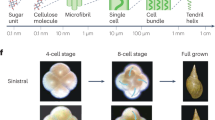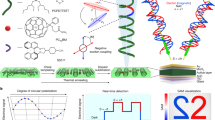Abstract
Chiral phonons are concerted mirror-symmetric movements of atomic groups connected by covalent and intermolecular bonds. Such lattice vibrations in crystals of biomolecules should be highly specific to their short- and long-range organizations, but their chiroptical signatures and structure–property relationships remain uncertain. Here we show that terahertz chiroptical spectroscopy enables the registration and attribution of chiral phonons for microscale and nanoscale crystals of amino acids and peptides. Theoretical analysis and computer simulations indicate that sharp mirror-symmetric bands observed for left- and right-handed enantiomers originate from the collective vibrations of biomolecules interconnected by hydrogen bonds into helical chains. The sensitivity of chiral phonons to minute structural changes can be used to identify physical and chemical differences in seemingly identical formulations of dipeptides used in health supplements. The generality of these findings is demonstrated by chiral phonons observed for amyloid nanofibrils of insulin. Their spectral signatures and polarization rotation strongly depend on their maturation stage, which opens a new door for medical applications of terahertz photonics.
This is a preview of subscription content, access via your institution
Access options
Access Nature and 54 other Nature Portfolio journals
Get Nature+, our best-value online-access subscription
$32.99 / 30 days
cancel any time
Subscribe to this journal
Receive 12 print issues and online access
$209.00 per year
only $17.42 per issue
Buy this article
- Purchase on SpringerLink
- Instant access to full article PDF
Prices may be subject to local taxes which are calculated during checkout






Similar content being viewed by others
Data availability
The data that support the plots within this paper and other findings of this study are available from the corresponding authors upon reasonable request.
Code availability
The analysis codes that support the findings of this study are available from the corresponding authors upon reasonable request.
References
Zhu, H. et al. Observation of chiral phonons. Science 359, 579–582 (2018).
Yuan, X. et al. The discovery of dynamic chiral anomaly in a Weyl semimetal NbAs. Nat. Commun. 11, 1259 (2020).
Yeom, J. et al. Chiromagnetic nanoparticles and gels. Science 359, 309–314 (2018).
Kurouski, D. Advances of vibrational circular dichroism (VCD) in bioanalytical chemistry. A review. Anal. Chim. Acta 990, 54–66 (2017).
Keiderling, T. A. Protein and peptide secondary structure and conformational determination with vibrational circular dichroism. Curr. Opin. Chem. Biol. 6, 682–688 (2002).
Chen, H., Wu, W., Zhu, J., Yang, S. A. & Zhang, L. Propagating chiral phonons in three-dimensional materials. Nano Lett. 21, 3060–3065 (2021).
Adu, K. W., Gutiérrez, H. R., Kim, U. J., Sumanasekera, G. U. & Eklund, P. C. Confined phonons in Si nanowires. Nano Lett. 5, 409–414 (2005).
Markelz, A. G., Roitberg, A. & Heilweil, E. J. Pulsed terahertz spectroscopy of DNA, bovine serum albumin and collagen between 0.1 and 2.0 THz. Chem. Phys. Lett. 320, 42–48 (2000).
Markelz, A., Whitmire, S., Hillebrecht, J. & Birge, R. THz time domain spectroscopy of biomolecular conformational modes. Phys. Med. Biol. 47, 3797–3805 (2002).
Walther, M., Plochocka, P., Fischer, B., Helm, H. & Uhd Jepsen, P. Collective vibrational modes in biological molecules investigated by terahertz time-domain spectroscopy. Biopolymers 67, 310–313 (2002).
Fischer, B., Walther, M. & Jepsen, P. U. Far-infrared spectroscopy of hydrogen bonding in nucleobases, nucleosides, and nucleotides. In Proc. IEEE Tenth International Conference on Terahertz Electronics 74–76 (IEEE, 2002).
Walther, M., Fischer, B. M. & Jepsen, P. U. Noncovalent intermolecular forces in polycrystalline and amorphous saccharides in the far infrared. Chem. Phys. 288, 261–268 (2003).
Williams, M. R. C., Aschaffenburg, D. J., Ofori-Okai, B. K. & Schmuttenmaer, C. A. Intermolecular vibrations in hydrophobic amino acid crystals: experiments and calculations. J. Phys. Chem. B 117, 10444–10461 (2013).
Rungsawang, R., Ueno, Y., Tomita, I. & Ajito, K. Angle-dependent terahertz time-domain spectroscopy of amino acid single crystals. J. Phys. Chem. B 110, 21259–21263 (2006).
Neu, J. et al. Terahertz spectroscopy of tetrameric peptides. J. Phys. Chem. Lett. 10, 2624–2628 (2019).
Korter, T. M. et al. Terahertz spectroscopy of solid serine and cysteine. Chem. Phys. Lett. 418, 65–70 (2006).
Singh, R., George, D. K., Benedict, J. B., Korter, T. M. & Markelz, A. G. Improved mode assignment for molecular crystals through anisotropic terahertz spectroscopy. J. Phys. Chem. A 116, 10359–10364 (2012).
Korter, T. M. & Plusquellic, D. F. Continuous-wave terahertz spectroscopy of biotin: vibrational anharmonicity in the far-infrared. Chem. Phys. Lett. 385, 45–51 (2004).
Day, G. M., Zeitler, J. A., Jones, W., Rades, T. & Taday, P. F. Understanding the influence of polymorphism on phonon spectra: lattice dynamics calculations and terahertz spectroscopy of carbamazepine. J. Phys. Chem. B 110, 447–456 (2006).
Williams, M. R. C. et al. Terahertz spectroscopy of enantiopure and racemic polycrystalline valine. Phys. Chem. Chem. Phys. 13, 11719–11730 (2011).
Choi, W. J. et al. Terahertz circular dichroism spectroscopy of biomaterials enabled by kirigami polarization modulators. Nat. Mater. 18, 820–826 (2019).
Dhillon, S. S. et al. The 2017 terahertz science and technology roadmap. J. Phys. D 50, 043001 (2017).
Hu, M. et al. Terahertz, infrared and Raman absorption spectra of tyrosine enantiomers and racemic compound. Spectrochim. Acta A 254, 119611 (2021).
Liu, Y., Zhou, T. & Cao, J.-C. Terahertz spectral of enantiomers and racemic amino acids by time-domain-spectroscopy technology. Infrared Phys. Technol. 96, 17–21 (2019).
True, A. B., Schroeck, K., French, T. A. & Schmuttenmaer, C. A. Terahertz spectroscopy of histidine enantiomers and polymorphs. J. Infrared Milli. Terahz. Waves 32, 691–698 (2011).
Shen, Y.-C. Terahertz pulsed spectroscopy and imaging for pharmaceutical applications: a review. Int. J. Pharm. 417, 48–60 (2011).
Zeitler, J. A. et al. Terahertz pulsed spectroscopy and imaging in pharmaceutical setting—a review. J. Pharm. Pharmacol. 59, 209–223 (2007).
Woutersen, S. et al. Peptide conformational heterogeneity revealed from nonlinear vibrational spectroscopy and molecular-dynamics simulations. J. Chem. Phys. 117, 6833–6840 (2002).
Rahman, A., Rahman, A. K. & Rao, B. Early detection of skin cancer via terahertz spectral profiling and 3D imaging. Biosens. Bioelectron. 82, 64–70 (2016).
Fitzgerald, A. J. et al. An introduction to medical imaging with coherent terahertz frequency radiation. Phys. Med. Biol. 47, R67 (2002).
Jeong, H. H. et al. Dispersion and shape engineered plasmonic nanosensors. Nat. Commun. 7, 11331 (2016).
Grimme, S., Bannwarth, C. & Shushkov, P. A robust and accurate tight-binding quantum chemical method for structures, vibrational frequencies, and noncovalent interactions of large molecular systems parametrized for all spd-block elements (Z = 1–86). J. Chem. Theory Comput. 13, 1989–2009 (2017).
Kim, Y. et al. Reconfigurable chiroptical nanocomposites with chirality transfer from the macro- to the nanoscale. Nat. Mater. 15, 461–468 (2016).
Provenzano, C., Pagliusi, P., Mazzulla, A. & Cipparrone, G. Method for artifact-free circular dichroism measurements based on polarization grating. Opt. Lett. 35, 1822–1824 (2010).
Ruggiero, M. T., Sibik, J., Orlando, R., Zeitler, J. A. & Korter, T. M. Measuring the elasticity of poly-l-proline helices with terahertz spectroscopy. Angew. Chem. Int. Ed. 55, 6877–6881 (2016).
Wukovitz, S. W. & Yeates, T. Why protein crystals favour some space-groups over others. Nat. Struct. Biol. 2, 1062–1067 (1995).
Jepsen, P. U. & Fischer, B. M. Dynamic range in terahertz time-domain transmission and reflection spectroscopy. Opt. Lett. 30, 29–31 (2005).
Yin, X., Schäferling, M., Metzger, B. & Giessen, H. Interpreting chiral nanophotonic spectra: the plasmonic Born–Kuhn model. Nano Lett. 13, 6238–6243 (2013).
Sala, J., Guàrdia, E. & Masia, M. The polarizable point dipoles method with electrostatic damping: implementation on a model system. J. Chem. Phys. 133, 234101 (2010).
Dos Santos, L. H. R., Krawczuk, A. & Macchi, P. Distributed atomic polarizabilities of amino acids and their hydrogen-bonded aggregates. J. Phys. Chem. A 119, 3285–3298 (2015).
Kühne, T. D. et al. CP2K: an electronic structure and molecular dynamics software package—Quickstep: efficient and accurate electronic structure calculations. J. Chem. Phys. 152, 194103 (2020).
Davies, C. L., Patel, J. B., Xia, C. Q., Herz, L. M. & Johnston, M. B. Temperature-dependent refractive index of quartz at terahertz frequencies. J. Infrared Milli. Terahz. Waves 39, 1236–1248 (2018).
Xie, L. et al. Temperature-dependent terahertz vibrational spectra of tetracycline and its degradation products. Spectrochim. Acta A 222, 117179 (2019).
Altfeder, I. et al. Scanning tunneling microscopy observation of phonon condensate. Sci. Rep. 7, 43214 (2017).
Lundholm, I. V. et al. Terahertz radiation induces non-thermal structural changes associated with Fröhlich condensation in a protein crystal. Struct. Dyn. 2, 054702 (2015).
Rimer, J. D. et al. Crystal growth inhibitors for the stones through molecular design. Science 330, 337–341 (2010).
Kawase, M. et al. Application of terahertz absorption spectroscopy to evaluation of aging variation of medicine. Anal. Sci. 27, 209–212 (2011).
Ow, S. Y. & Dunstan, D. E. A brief overview of amyloids and Alzheimer’s disease. Protein Sci. 23, 1315–1331 (2014).
Ivanova, M. I., Sievers, S. A., Sawaya, M. R., Wall, J. S. & Eisenberg, D. Molecular basis for insulin fibril assembly. Proc. Natl Acad. Sci. USA 106, 18990–18995 (2009).
Jiménez, J. L. et al. The protofilament structure of insulin amyloid fibrils. Proc. Natl Acad. Sci. USA 99, 9196–9201 (2002).
Acknowledgements
This work was supported by Vannevar Bush DoD Fellowship to N.A.K. titled ‘Engineered Chiral Ceramics’ ONR N000141812876, ONR COVID-19 Newton Award ‘Pathways to Complexity with “Imperfect” Nanoparticles’ HQ00342010033. This study was also supported in part by the US Defense Advanced Research Projects Agency (DARPA) RadioBio programme under contract HR00111720067, by the Office of Naval Research (MURI N00014-20-1-2479) and by AFOSR FA9550-20-1-0265. Additionally, the computational part of this work was supported by the Brazilian funding agencies CAPES (finance code 001), CNPq (311353/2019-3) and FAPESP (processes 2012/15147-4 and 2013/07296-2), and the high-performance computer resources provided by the SDumont supercomputer at the National Laboratory for Scientific Computing (LNCC/MCTI, Brazil) and Cloud@UFSCar. We acknowledge the Cambridge Crystallographic Data Centre for the collection of single-crystal data and use of the Mercury software. K.Y. thanks the Japan Society for the Promotion of Science for a JSPS Young Scientist Fellowship and the Overseas Research Program of the Yoshida Foundation for Science and Technology. We also acknowledge the financial support of the University of Michigan College of Engineering and NSF grant no. DMR-0723032, as well as technical support from the Michigan Center for Materials Characterization.
Author information
Authors and Affiliations
Contributions
W.J.C. and N.A.K. designed the project. K.Y. recrystallized the AAs and dipeptides and conducted the PXRD analysis and size distribution analysis. J.-Y.K., W.J.C. and K.S. conducted the SEM and TEM imaging. W.J.C. measured all the THz spectra and developed the algorithm for TA, TCD and TORD. Dynamic time-warping, correlation matrix and violin plots were performed by M.C. W.J.C. and S.H.L. developed the algorithm for the BK theory and S.H.L. conducted the parametric fitting using the nonlinear regression method. F.M.C. and A.F.d.M. conducted the density functional theory simulation and analysed the data. Y.W. performed the MD simulation. J.M.K. removed the cystine stones in clinical purpose and provided them as samples. All the authors discussed the results. W.J.C., A.F.d.M. and N.A.K. wrote the manuscript.
Corresponding authors
Ethics declarations
Competing interests
The authors declare no competing interests.
Peer review
Peer review information
Nature Photonics thanks the anonymous reviewers for their contribution to the peer review of this work.
Additional information
Publisher’s note Springer Nature remains neutral with regard to jurisdictional claims in published maps and institutional affiliations.
Supplementary information
Supplementary Information
Supplementary Methods, Discussion, Figs. 1–29 and Tables 1–5.
Supplementary Video 1
Video of single-molecular vibrations.
Supplementary Video 2
Video of chiral phonons.
Rights and permissions
About this article
Cite this article
Choi, W.J., Yano, K., Cha, M. et al. Chiral phonons in microcrystals and nanofibrils of biomolecules. Nat. Photon. 16, 366–373 (2022). https://doi.org/10.1038/s41566-022-00969-1
Received:
Accepted:
Published:
Issue Date:
DOI: https://doi.org/10.1038/s41566-022-00969-1
This article is cited by
-
Backscattering-free edge states below all bands in two-dimensional auxetic media
Nature Communications (2025)
-
Sustainable Materials Enabled Terahertz Functional Devices
Nano-Micro Letters (2025)
-
Ultra-wideband terahertz fingerprint enhancement sensing and inversion model supported by single-pixel reconfigurable graphene metasurface
PhotoniX (2024)
-
THz generation by exchange-coupled spintronic emitters
npj Spintronics (2024)
-
Materials for chiral light control
Nature Reviews Materials (2023)



